- Расшифровка кодов ошибок WJ/WG
- Бортжурналы
- Jeep Grand Cherokee Trailhawk 2017
- Последние записи
- Течь расширительного бачка
- Jeep WJ Grand Cherokee Diagnostic Trouble Codes
- OBD (On-Board Diagnostic) systems
- Malfunction Indicator Lamp (MIL)
- MIL illumination
- Retrieving codes:
- Erasing codes:
- OBD-II related links:
- Chrysler Diagnostic Trouble Codes
Расшифровка кодов ошибок WJ/WG
Вы можете написать сейчас и зарегистрироваться позже. Если у вас есть аккаунт, авторизуйтесь, чтобы опубликовать от имени своего аккаунта.
Бортжурналы
Jeep Grand Cherokee Trailhawk 2017
Последние записи
Течь расширительного бачка
Эпопея с системой охлаждения!
О замене бачка писал, опишу проблему подробнее, возможно кому-то пригодится.
Из бачка стал уходить антифриз, видимых потёков не было, я напрягся и стал наблюдать.
Смотрел на уровень в бачке после ночной стоянки, система ж должна остыть, давление выровняться. Во время пуска двигателя смотрел на выхлопные газы. Почитал статьи про систему охлаждения, все пишут про прогоревшие прокладки, в общем жуть. Продолжалось это несколько месяцев. Антифриз периодически уходил, а я его подливал. Однажды поднял капот сразу после поездки по городу и вижу блестит коса проводов, которая проходит примерно под бачком. Трогаю её пальцем — палец красный. Думаю вот оно. Начинаю лазить искать. Включил фронтальную камеру на телефоне и засунул телефон под бачок, а там висит капля и дренажная трубка мокрая.

Всё вытер, выровнял уровень в бачке и стал ждать. А антифриз не уходит.
В итоге моих наблюдений оказалось, что на самом дне бачка, в самой его нижней точке, похоже образовалась микротрещина. При езде по городу, когда система охлаждения максимально разогревалась и создавалось максимально высокое давление, бачок начинал течь. Но тёк не сильно, поэтому до утра в подкапотном всё высыхало.
При этом автомобиль 2017 года, какого хрена бачок треснул непонятно.
Поставил новый бачок, заменил на нём крышку, и уже как порядка 2000 км этой проблемы нет. Но фобия осталась и литр антифриза всегда лежит в багажнике.
Всем добра и крепких бачков!
Jeep WJ Grand Cherokee Diagnostic Trouble Codes
Welcome to the JeepSpecs.com in-depth page on WJ Generation Jeep Grand Cherokee diagnostic trouble codes. We have organized as much information as we could find into a helpful article below. Is something incorrect or missing? Please get in touch with us and we’ll fix it!
OBD (On-Board Diagnostic) systems
Location and pinouts for the Diagnostics Connector
OBD systems are found in most vehicles in use today. OBD is an electronic system designed to control engine functions and diagnose engine problems or component failures, as well as minimize emissions. OBD-II, a new standard introduced in cars built after January 1, 1996, provides almost complete engine control and also monitors parts of the chassis, body and accessory components, as well as the diagnostic control network of the vehicle.
OBD-II equipped vehicles have a connector located in the passenger compartment, usually accessible from the driver’s seat (under the dash above the hood release lever in the Grand Cherokee WJ). A cable is plugged into the OBD-II connector and connected to a scanning tool. This can range from a simple hand-held meter that provides a coded read-out of the various diagnostic functions, up to a large console computer-based unit costing thousands of dollars.
Fault codes usually appear after the “Check Engine” light has come on. The data provided by the OBD-II system can sometimes pinpoint the specific component that has malfunctioned, saving substantial service time and cost. Scanning OBD-II signals can also provide important information when purchasing a used vehicle. Recent introductions of less costly scanning devices have allowed home mechanics and small shops accessibility to OBD-II signals to use them for their own testing and repairs.
Malfunction Indicator Lamp (MIL)
In the Grand Cherokee WJ, the MIL gives an indication to the vehicle operator when the Powertrain Control Module (PCM) has recorded a Diagnostic Trouble Code (DTC) for an On-Board Diagnostics II (OBDII) emissions-related circuit or component malfunction. The MIL is controlled by a transistor on the instrument cluster circuit board based upon cluster programming and electronic messages received by the cluster from the PCM over the Programmable Communications Interface (PCI) data bus.
The MIL bulb is completely controlled by the instrument cluster logic circuit, and that logic will only allow this indicator to operate when the instrument cluster receives a battery current input on the fused ignition switch output (run-start) circuit. Therefore, the bulb will always be off when the ignition switch is in any position except On or Start. The bulb only illuminates when it is provided a path to ground by the instrument cluster transistor.
The instrument cluster will turn on the MIL for the following reasons:
BULB TEST – Each time the ignition switch is turned to the On position the MIL is illuminated for about three seconds as a bulb test.
MIL LAMP-ON MESSAGE – Each time the cluster receives a MIL lamp-on message from the PCM, the indicator will be illuminated. The indicator can be flashed on and off, or illuminated solid, as dictated by the PCM message. For some DTC’s, if a problem does not recur, the PCM will send a lamp-off message automatically. Other DTC’s may require that a fault be repaired and the PCM be reset before a lamp-off message will be sent.
COMMUNICATIONS ERROR – If the cluster receives no lamp-on or lamp-off messages from the PCM for twenty consecutive seconds, the MIL is illuminated by the instrument cluster. The indicator remains controlled and illuminated by the cluster until a valid lamp-on or lamp-off message is received from the PCM.
MIL illumination
In many instances, emissions systems must fail diagnostic tests more than once before the PCM illuminates the MIL. These tests are know as ‘two trip monitors.’ Other tests that turn the MIL lamp on after a single failure are known as ‘one trip monitors.’ A trip is defined as ‘start the vehicle and operate it to meet the criteria necessary to run the given monitor.’
Certain conditions such as a loose or missing gas cap, poor fuel quality, etc. may illuminate the light after engine start. The vehicle should be serviced if the light stays on through several typical driving cycles. In most situations, the vehicle will drive normally and will not require towing.
Prolonged driving with the “Malfunction Indicator Light” or “Check Engine” light on could cause further damage to the emission control system. It could also affect fuel economy and driveability. The vehicle must be repaired before any emissions test can be performed.
If the light is flashing, severe catalytic converter damage and power loss will soon occur. Immediate service is required.
Retrieving codes:
Turn the ignition key until the digital odometer displays, repeat three times in succession and then back to “On” (On/Off, On/Off, On/Off, On). At the fourth “On” the odometer will be replaced with codes. If no codes are present then “Done” will appear.
Erasing codes:
After three good trips the MIL is extinguished and the Task Manager automatically switches the trip counter to a warm-up cycle counter. DTCs are automatically erased following 40 warm-up cycles if the component does not fail again.
DTCs can be erased anytime with a DRB III. Erasing the DTC with the DRB III erases all OBD II information. The DRB III automatically displays a warning that erasing the DTC will also erase all OBD II monitor data. This includes all counter information for warm-up cycles, trips and Freeze Frame.
OBD-II related links:
Chrysler Diagnostic Trouble Codes
| A Diagnostic Trouble Code (DTC) indicates that the Powertrain Control Module (PCM) has recognized an abnormal condition in the system. DTC’s are the results of a system or circuit failure, but do not directly identify the failed component or components. |
| Code example | 1st Digit | 2nd Digit | 3rd Digit |
| P 0 1 0 0 1 2 3 4 5 | P = powertrain | 0 = Standard 1 = Manufacturer specific 2 = ? | 1 = Emission management 2 = Injector circuit 3 = Ignition 4 = Auxiliary emission 5 = Vehicle speed & idle control 6 = Computer & output circuit 7 = Transmission 8 = ? 9 = ? |
- (M) Check Engine Lamp (MIL) will illuminate during engine operation if this Diagnostic Trouble Code was recorded (depending if required by CARB and/or EPA). MIL is displayed as an engine icon on the instrument cluster.
- (G) Generator Lamp Illuminated
- Chrysler uses ISO 9142-2 OBDII Communications Protocol
DRB Scan Tool Display
Description of Diagnostic Trouble Code
DRB Scan Tool Display
Description of Diagnostic Trouble Code
DRB Scan Tool Display
Description of Diagnostic Trouble Code
DRB Scan Tool Display
Description of Diagnostic Trouble Code
DRB Scan Tool Display
Description of Diagnostic Trouble Code
DRB Scan Tool Display
Description of Diagnostic Trouble Code
DRB Scan Tool Display
Description of Diagnostic Trouble Code
DRB Scan Tool Display
Description of Diagnostic Trouble Code
DRB Scan Tool Display
Description of Diagnostic Trouble Code
DRB Scan Tool Display
Description of Diagnostic Trouble Code
DRB Scan Tool Display
Description of Diagnostic Trouble Code
DRB Scan Tool Display
Description of Diagnostic Trouble Code
DRB Scan Tool Display
Description of Diagnostic Trouble Code
DRB Scan Tool Display
Description of Diagnostic Trouble Code
DRB Scan Tool Display
Description of Diagnostic Trouble Code
DRB Scan Tool Display
Description of Diagnostic Trouble Code
DRB Scan Tool Display
Description of Diagnostic Trouble Code
Description of Diagnostic Trouble Code
| Special thanks to Ed at PT Do It Yourself.net for providing additional listings and information for this page. |

